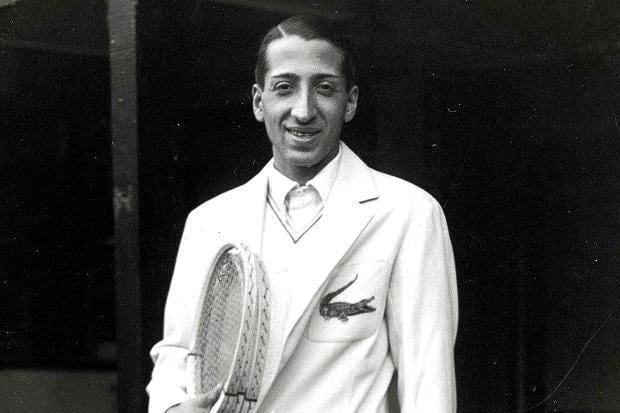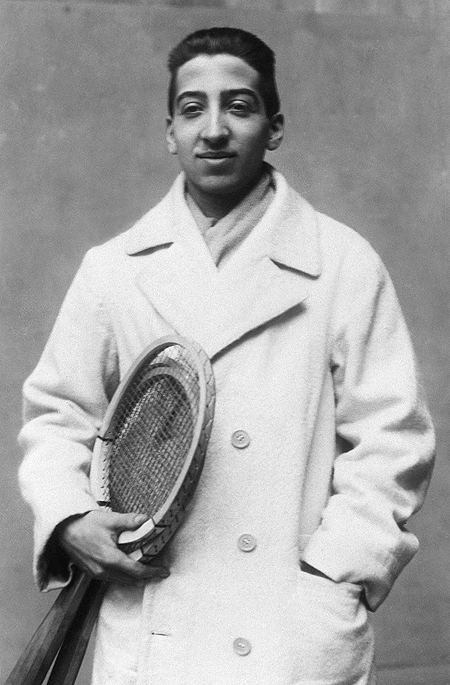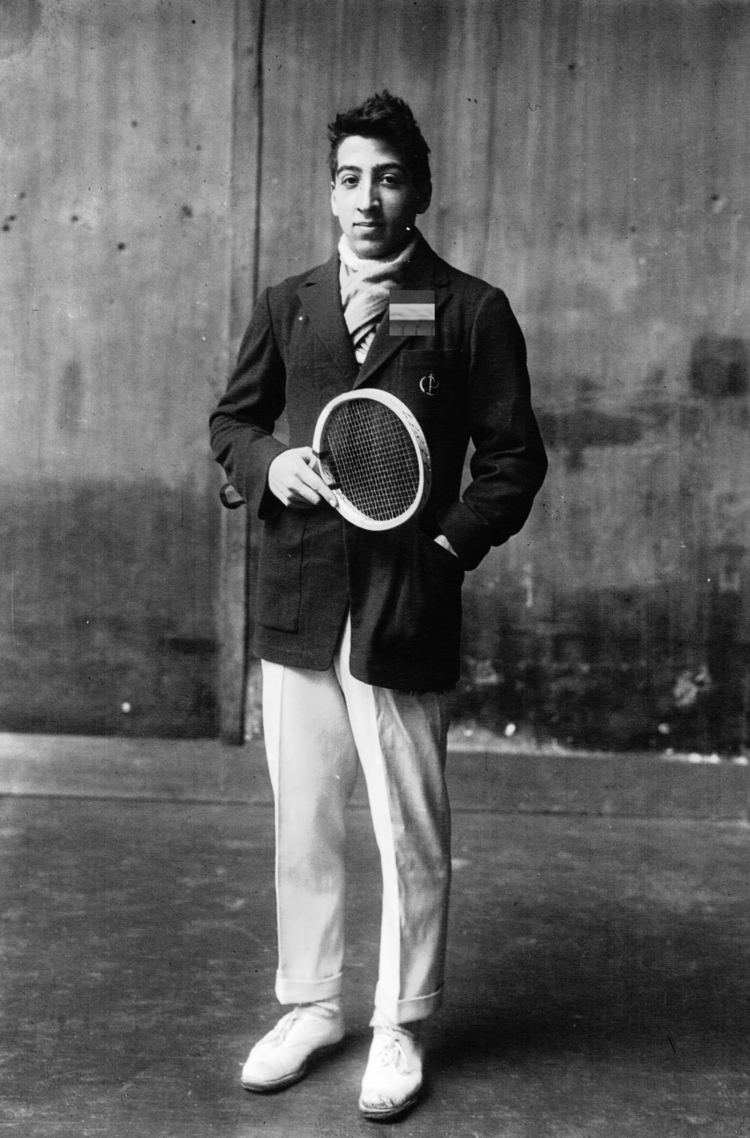Retired 1932 | French Open W (1925, 1927, 1929) Organizations founded Lacoste | |
 | ||
Plays Right-handed (one-handed backhand) Highest ranking No. 1 (1926, A. Wallis Myers) Parents Jeanne-Marie Magdeleine Larrieu-Let, Jean-Jules Lacoste Similar People Andre Gillier, Bernard Lacoste, Jean Borotra, Henri Cochet, Catherine Lacoste | ||
Int. Tennis HoF 1976 (member page) | ||
The History of Rene Lacoste
Jean René Lacoste ([ʒɑ̃ ʁəne laˈkɔst]; 2 July 1904 – 12 October 1996) was a French tennis player and businessman. He was nicknamed "the Crocodile" by the press after they learned of a wager Lacoste made with the French Davis Cup captain, who promised Lacoste a crocodile-skin handbag if Lacoste won; he is also known worldwide as the creator of the Lacoste tennis shirt, which he introduced in 1929.
Contents
- The History of Rene Lacoste
- Ren lacoste
- Tennis career
- Playing style
- Business career
- Personal life
- References

Lacoste was one of The Four Musketeers with Jean Borotra, Jacques Brugnon, and Henri Cochet, French tennis stars who dominated the game in the late 1920s and early 1930s. He won seven Grand Slam singles titles at the French, American, and British championships and was an eminent baseline player and tactician of the pre-war period. As a member of the French team, Lacoste won the Davis Cup in 1927 and 1928. Lacoste was the World No. 1 player for both 1926 and 1927.

Ren lacoste
Tennis career

Lacoste started playing tennis at age 15 when he accompanied his father on a trip to England. His first participation in a Grand Slam tournament was the 1922 Wimbledon Championships in which he lost in the first round to Pat O'Hara Wood. The following year, 1923, he reached the fourth round at Wimbledon to be narrowly defeated by Cecil Campbell, and he competed for the first time in the U.S. Championships.

His breakthrough came in 1925 when he won the singles title at the French Championships and at Wimbledon, in both cases after a victory in the final against compatriot Jean Borotra. The following year, 1926, Lacoste lost his French title after a straight-sets defeat in the final to Henri Cochet. He did not compete at Wimbledon that year, but in September he won the U.S. National Championships title against Borotra. He was ranked No.1 for 1926 by A. Wallis Myers, tennis correspondent of The Daily Telegraph.

In 1927, dubbed 'The finest year in tennis history' by E. Digby Baltzell, Lacoste was part of the French team that captured the Davis Cup from the United States, ending the latter's 6-year title run. The final was played at the Germantown Cricket Club in Philadelphia and Lacoste won both his singles matches against Bill Johnston and Bill Tilden. He played Tilden in two Grand Slam tournament finals that year and won both of them. At the French Championships he was victorious in five sets; at the U.S. National Championships he defended his title and denied Tilden his seventh U.S. title by winning in straight sets, although he survived setpoints in the first and third set and was down a break in the second. At Wimbledon Lacoste lost a five-set semifinal to Borotra. For the second successive year he was ranked No.1.
In 1928 Lacoste lost his French title after a four-set loss in the final against Cochet. He took revenge by beating Cochet in the final of the Wimbledon Championships after having defeated Tilden in a five-set semifinal. The Challenge Round of the 1928 Davis Cup against the United States was played at the Stade Roland Garros in Paris on 27–29 July. The stadium was specifically constructed to host France's first defense of the Davis Cup. Lacoste lost the first rubber in a five-set match to Tilden but France won the remaining rubbers to defeat the challengers 4–1 and retain the cup. Lacoste did not participate in the 1928 U.S. Championships.
Between 1923 and 1928 Lacoste played 51 Davis Cup matches for France in 26 ties and compiled a record of 32–8 in singles and 8–3 in Doubles.
The only major championship he played in 1929 was the French and he won his seventh, and last, Grand Slam singles title after a tight five-set final against Jean Borotra. Failing health, including respiratory disease, led to his withdrawal from competitive tennis in 1929 although he would make a brief comeback at the 1932 French Championships, where he defeated reigning Wimbledon champion Sidney Wood in the third round, but lost in the fourth to Harry Lee. He was the non-playing captain of the French Davis Cup team in 1932 and 1933.
The Four Musketeers were inducted simultaneously into the International Tennis Hall of Fame, in Newport, Rhode Island, in 1976. In his 1979 autobiography, Jack Kramer, the long-time tennis promoter and great player himself, included Lacoste in his list of the 21 greatest players of all time.
In 1928 Lacoste authored a book titled 'Lacoste on Tennis' .
There are numerous explanations of why Lacoste was originally nicknamed "the Crocodile". A 2006 New York Times obituary about Lacoste's son, Bernard, provides an apparently authoritative one. In the 1920s, supposedly, Lacoste made a bet with his team captain about whether he would win a certain match. The stakes were a suitcase he had seen in a Boston store; it was made of crocodile (or alligator) skin. Later, René Lacoste's friend Robert George embroidered a crocodile onto a blazer that Lacoste wore for his matches.
Playing style
Lacoste was primarily a baseline player who relied on control, accuracy, and deeply-placed groundstrokes to put pressure on his opponents. In addition he possessed an excellent passing shot and backhand slice. Nicknamed the 'Tennis Machine' for his methodical game and ability to avoid errors, he was known as a devoted and hard-working player rather than a player with a great amount of natural talent. His style was a complete contrast to that of his fellow Musketeer Henri Cochet. Lacoste was a studious tactician who meticulously analysed his opponents and kept detailed notes on their strengths and weaknesses.
Business career
In 1933, Lacoste founded La Société Chemise Lacoste with André Gillier. The company produced the tennis shirt, also known as polo shirt, which Lacoste often wore when he was playing, which had a crocodile (often thought to be an alligator) embroidered on the chest. In 1963 his son Bernard took over the management of the company.
In 1961, Lacoste created an innovation in racket technology by unveiling and patenting the first tubular steel tennis racket. At that time, wood rackets were the norm; the new version's strings were attached to the frame by a series of wires, which wrapped around the racket head. The steel-tube racket was stiffer, and imparted a greater force to the ball during a stroke. It was marketed in Europe under the Lacoste brand, but in the United States it was marketed by Wilson Sporting Goods. Pierre Darmon debuted the racket at Wimbledon in 1963 but it achieved critical acclaim and huge popularity as the Wilson T-2000, used by American tennis greats Billie Jean King and Jimmy Connors.
When Lacoste died, French Advertising agency Publicis, who had been managing his company's account for decades, published a print ad with the Lacoste logo and the English words "See you later...", reinforcing the idea that the animal was perhaps an alligator.
Personal life
On 30 June 1930 he married the famous golfing champion, Simone de la Chaume. Their daughter Catherine Lacoste was a champion golfer and president of the Golf Club Chantaco, founded by her mother, at a few kilometres from St. Jean-de-Luz.
